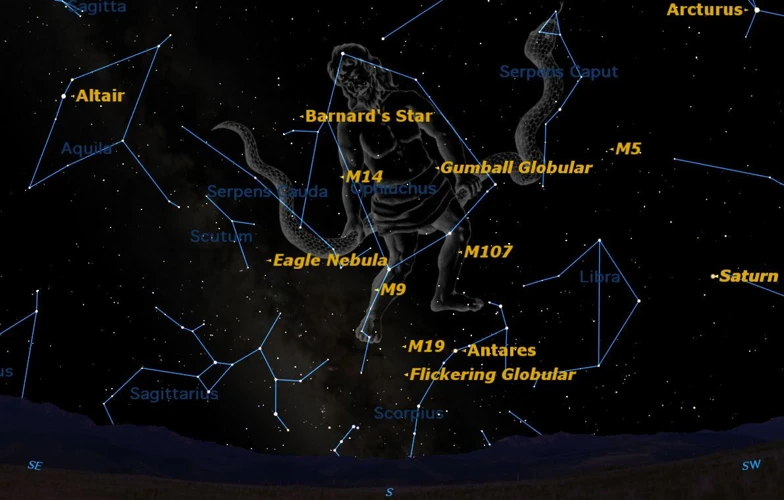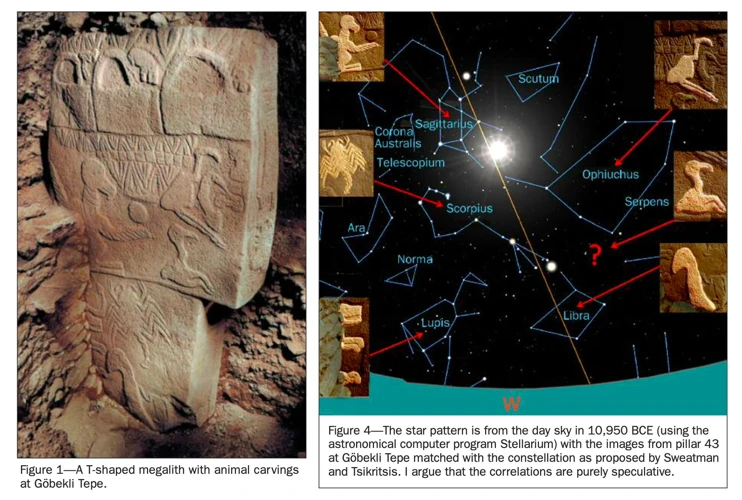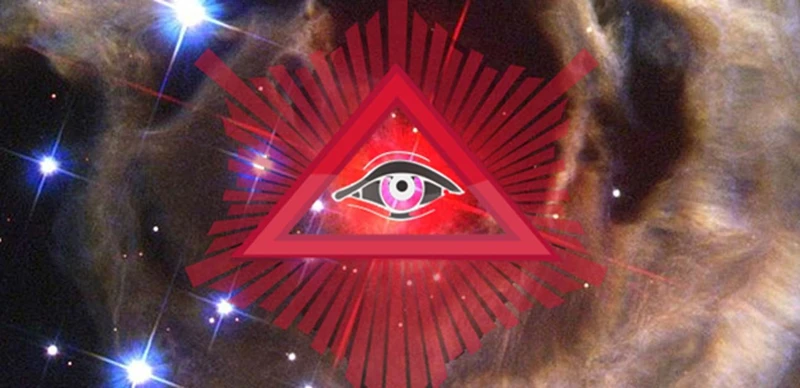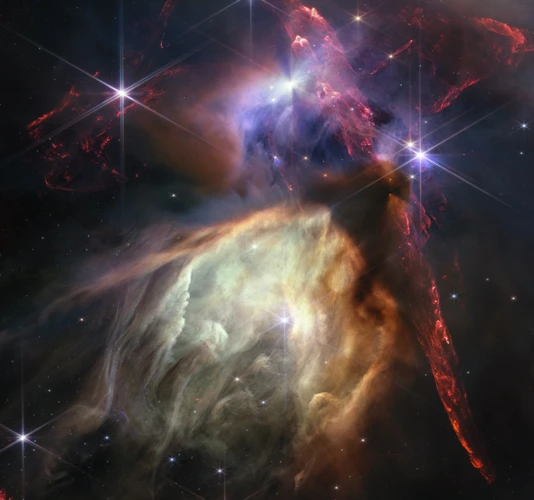Uncovering the Forgotten Ancient Constellations: Rediscovering the Celestial Legends of the Past
Have you ever gazed up at the night sky and wondered about the stories behind the constellations? While we are familiar with the well-known star formations like Orion and Ursa Major, there are countless other celestial legends that have been lost to time. These forgotten ancient constellations hold a wealth of knowledge and cultural significance, offering us a deeper understanding of our ancestors’ beliefs and mythology. Join us on an extraordinary journey as we explore the vanishing constellations of ancient Egypt, Mesopotamia, and Mesoamerica. From the Lion’s Mane and the Jade Rabbit to the Great Archer and the Feathered Serpent, let us unveil these celestial tales that have been hidden in the depths of history. Prepare to be amazed and captivated by the long-lost wonders that await in the starry skies above.
Contents
- The Importance of Constellations
- The Lost Constellations of Ancient Egypt
- The Vanished Stars of Mesopotamia
- The Lost Zodiacs of Mesoamerica
- Unearthing Forgotten Legends
- The Modern Rediscovery
- Conclusion
-
Frequently Asked Questions
- 1. How were constellations used for navigation in ancient times?
- 2. Were constellations only used for practical purposes?
- 3. Are constellations the same across different cultures?
- 4. Can we still see the ancient constellations today?
- 5. Why were animals often depicted in ancient constellations?
- 6. Is there a connection between zodiac signs and ancient constellations?
- 7. Did ancient civilizations use constellations to predict future events?
- 8. How did ancient cultures pass down knowledge about constellations?
- 9. What role did constellations play in religious ceremonies?
- 10. Can we still learn from the forgotten ancient constellations?
- References
-
Frequently Asked Questions
- What are constellations?
- Why were constellations important in ancient times?
- Why were some constellations forgotten?
- What were the lost constellations of ancient Egypt?
- What were the vanished stars of Mesopotamia?
- What were the lost zodiacs of Mesoamerica?
- How were the forgotten constellations rediscovered?
- What can we learn from the forgotten constellations?
- Are there any modern constellations that might be forgotten in the future?
- Can anyone create their own constellation?
- References
- Read More
The Importance of Constellations

Constellations have played a crucial role throughout history, serving as essential tools for navigation, timekeeping, and storytelling. These celestial patterns provided a way for early civilizations to map out the vast expanse of the night sky and make sense of their surroundings. By identifying and naming these star formations, ancient cultures were able to create intricate mythologies and belief systems that connected the celestial realm with the earthly realm. Constellations also served practical purposes, guiding travelers across deserts and oceans, establishing calendars, and marking significant celestial events such as solstices and equinoxes. These astral configurations served as a means of passing down knowledge, traditions, and values across generations. The stories embedded within the constellations were often tied to cultural practices, offering moral lessons, and reinforcing societal norms. For example, in ancient Egypt, the constellation of the Lion’s Mane symbolized strength and courage, inspiring warriors in battle. Similarly, in ancient Mesopotamia, the Celestial Bull represented fertility and abundance, reflecting the agricultural importance of the region. The constellations not only connected ancient civilizations to the cosmos but also highlighted their unique beliefs, customs, and histories. Today, while we may no longer rely on constellations for practical purposes, their impact on human culture and spirituality should not be forgotten. As we delve into the forgotten ancient constellations, we gain a greater appreciation for the interconnectedness of humanity, the vastness of the universe, and the enduring power of storytelling.
The Lost Constellations of Ancient Egypt

Ancient Egypt, known for its rich mythology and cultural heritage, had a unique set of constellations that have been largely forgotten in modern times. One of these lost constellations was the Lion’s Mane. Depicting the majestic mane of a lion, this constellation symbolized strength, power, and courage; attributes that were highly revered in Egyptian society. It was believed that those who were born under this constellation possessed the qualities of bravery and leadership. Another forgotten constellation was the Serpent’s Tail, which represented rebirth and protection. Egyptians believed that this constellation guarded against evil forces and brought about spiritual transformation. Lastly, the Goddess Isis, a revered deity in ancient Egyptian religion, was immortalized in the night sky as a constellation. This celestial figure represented femininity, wisdom, and divine magic. The presence of these forgotten constellations in Egyptian mythology offers a glimpse into the profound significance of celestial symbolism in their culture, reflecting their beliefs in the power of nature, the divine, and the human spirit.
The Lion’s Mane
The Lion’s Mane constellation, also known as Leo, has a rich history and holds great significance in ancient Egyptian mythology. This celestial formation is an important representation of strength, power, and leadership. In Egyptian culture, the lion was seen as a symbol of royalty and divine authority. The Lion’s Mane constellation was associated with the mighty lion-headed goddess Sekhmet, known as the goddess of war, healing, and protection. According to the ancient Egyptians, Sekhmet’s roar brought forth the scorching heat of the sun, and her ferocity was feared by enemies. This constellation served as a guiding light for warriors and was believed to bestow courage and bravery upon those who looked up to it. The Lion’s Mane constellation also played a role in the annual flood of the Nile, which was vital for Egypt’s agriculture. Its positioning in the sky marked the beginning of the flooding season, symbolizing the renewal and fertility brought by the floodwaters. The ancient Egyptians held elaborate rituals and ceremonies to honor the Lion’s Mane and ensure the prosperity of their land. To this day, the constellation of the Lion’s Mane continues to inspire awe and represents the enduring power and majesty associated with lions.
The Serpent’s Tail
In the constellation lore of ancient Egypt, one of the forgotten constellations is “The Serpent’s Tail.” This celestial formation, located in the southern skies, held significant spiritual and symbolic meaning for ancient Egyptians. The Serpent’s Tail represented the duality of life and death, creation and destruction. The serpent has long been a potent symbol across various cultures, often associated with wisdom, healing, and transformation. In ancient Egypt, it was believed that the Serpent’s Tail was a gateway to the underworld, a realm of the afterlife. Egyptians believed that by aligning themselves with this constellation, they could gain insight into the mysteries of death and the cycle of rebirth. The Serpent’s Tail was highly revered during sacred rituals and depicted in elaborate tomb art, emphasizing its importance in the journey of the soul. This celestial formation often intertwined with the mythology of the goddess Isis, a central figure in ancient Egyptian religion. Isis was believed to have power over life and death, and her connection to the Serpent’s Tail added to her depiction as a divine protector and guide in the realm beyond. The symbolism of The Serpent’s Tail highlights the ancient Egyptians’ deep spiritual beliefs and their profound understanding of the interconnectedness between life and death. Today, we can look at this forgotten constellation as a reminder of the enduring wisdom and eternal quest for understanding that continues to captivate us.
The Goddess Isis
The Goddess Isis, a prominent figure in ancient Egyptian mythology, was associated with various constellations in the night sky. One of these constellations, known as the “Thigh of Isis,” represented her powerful presence and influence. This celestial formation was believed to embody her role as a mother goddess, symbolizing fertility and the nurturing aspect of creation. The Thigh of Isis constellation was often depicted as a starry region encompassing the area between the constellations of Orion and Gemini. In Egyptian mythology, Isis was revered as the goddess of magic, wisdom, and healing. Her celestial representation in the night sky highlighted her connection to the natural world and her ability to bring forth life and abundance. The stories and legends surrounding Isis served as a source of inspiration and guidance for the ancient Egyptians, with rituals and ceremonies devoted to her worship. This reverence for the goddess Isis played a significant role in shaping the religious and cultural practices of ancient Egypt. To this day, her mythological influence can still be felt, as her story continues to captivate and fascinate those who seek a deeper understanding of the ancient world.
The Vanished Stars of Mesopotamia

The ancient civilization of Mesopotamia, nestled between the Tigris and Euphrates rivers, held a profound fascination with the stars above. Their vanished constellations reveal a rich tapestry of mythologies and astronomical knowledge. One such constellation is the Celestial Bull, which held great significance in Mesopotamian culture. Representing fertility, abundance, and power, this celestial beast symbolized the strength of the land and the prosperity it brought. Another constellation that graced the Mesopotamian sky was The Scorpion’s Sting, associated with the god Ninurta and believed to safeguard against evil forces. Finally, The Great Archer constellation depicted a mighty hero preparing to release his bow, embodying the Mesopotamian belief in the art of the hunt and the virtues of bravery and skill. These forgotten celestial formations offer a glimpse into the profound relationship between the Mesopotamians and the heavens above, showcasing their expertise in astronomy and their reverence for the natural world.
The Celestial Bull
The Celestial Bull is one of the lost constellations of ancient Mesopotamia, encapsulating the rich cultural and agricultural significance of the region. In Mesopotamian mythology, the bull symbolized fertility, strength, and prosperity. It was believed that the movements of the Celestial Bull in the night sky were closely linked to the changing seasons and the success of agricultural endeavors. Farmers would observe the position of the constellation to determine the optimal time for planting and harvesting their crops. The Bull’s presence in the heavens represented the abundance of the land and the blessings of the gods. This celestial creature was associated with the god of agriculture, ensuring the fertility of the soil and the prosperity of the people. The mythology of the Celestial Bull often intersected with stories of epic battles and heroic figures. For example, the myth of Gilgamesh, a legendary Mesopotamian hero, involved a confrontation with the Bull of Heaven, representing the forces of chaos and destruction. The story symbolized the struggle between humanity and the untamed natural world. Today, the Celestial Bull may have faded from modern astronomical maps, but its legacy continues to inspire and remind us of the deep connections between human culture and the cycles of nature. It serves as a reminder of the importance of honoring the natural world and recognizing the interdependence between humans and the environment in which they flourish.
The Scorpion’s Sting
In the ancient constellation lore of Mesopotamia, the Scorpion’s Sting held great significance. This celestial formation, also known as Scorpius, represented one of the most recognizable constellations in the night sky. The Scorpion’s Sting was associated with various mythologies and beliefs across different cultures. In Mesopotamia, it was believed that the Scorpion’s Sting was associated with the goddess Ishtar, the embodiment of love and war. The prominent red star Antares, often referred to as the “heart of the scorpion,” was believed to be the focal point of the constellation. This star represented the scorpion’s lethal sting. The Scorpion’s Sting was also connected to the underworld and the concept of death and rebirth. Its presence in the sky during certain times of the year signified the transition between the seasons. This constellation was crucial for agricultural communities, as it marked the beginning and end of planting and harvesting seasons. The Scorpion’s Sting was also used for navigation. Its distinct shape helped ancient mariners navigate through the treacherous seas, guiding them to their destinations. Discovering the stories and symbolism behind the Scorpion’s Sting allows us to appreciate the interconnectedness of ancient civilizations and their relationship with the celestial world. To this day, this constellation continues to fascinate astronomers and stargazers alike, providing a glimpse into the rich tapestry of our celestial heritage.
The Great Archer
The Great Archer constellation, also known as Sagittarius, has a rich and fascinating history that spans across ancient civilizations. In Mesopotamian culture, this celestial figure was associated with the mythical hero Gilgamesh, known for his archery prowess and extraordinary adventures. According to ancient texts, the Great Archer was believed to guard the pathway to the divine realm, shooting arrows that acted as cosmic markers for celestial events. The constellation’s position along the ecliptic, the apparent path of the sun, moon, and planets, made it particularly significant for astrological predictions and interpretations. The arrow fired by the Great Archer was seen as a symbol of power, exploration, and the pursuit of knowledge. In Greek mythology, the constellation was associated with the centaur Chiron, a wise and skilled teacher of heroes. Chiron’s connection to healing and medicine is reflected in the modern-day astrological sign Ophiuchus, which is often linked to the Great Archer. The mythology surrounding the Great Archer serves as a reminder of our ancestors’ reverence for the celestial realm and their desire to interpret the mysteries of the cosmos. As we explore the lost constellations, we are reminded of the enduring fascination humanity has with the stars above.
The Lost Zodiacs of Mesoamerica

In the ancient civilization of Mesoamerica, a rich tapestry of celestial legends and zodiacs existed, offering a unique glimpse into the spiritual beliefs and cosmology of these ancient peoples. Among the lost zodiacs of Mesoamerica are three prominent celestial symbols that held great significance in their culture. One of these is the Feathered Serpent, a powerful deity associated with creation, wisdom, and the renewal of life. The Jade Rabbit, another revered figure, represented the moon and was believed to govern fertility and agriculture, bringing prosperity to the land. Lastly, the Cosmic Butterfly symbolized transformation and the cycle of life and death, signifying the inevitable changes that occur within the natural world. These lost zodiacs played a central role in Mesoamerican rituals, ceremonies, and worldviews, connecting the heavens with daily life. They were guides for sacred rituals, celestial calendars, and divination practices. Exploring the forgotten ancient constellations of Mesoamerica allows us to uncover the complex interplay between spirituality, astronomy, and the natural world in this extraordinary civilization. (Anchor text: sacred rituals and beliefs of the ancient Mayans).
The Feathered Serpent
The Feathered Serpent is a celestial legend that originates from the rich mythology of Mesoamerica. In ancient Aztec and Mayan cultures, this constellation represented the divine entity Quetzalcoatl, a significant deity associated with wisdom, creation, and fertility. The Feathered Serpent was believed to be a bridge between the earthly and celestial realms, embodying the duality of life and death, light and darkness. This extraordinary constellation was said to bring balance and harmony to the cosmos, influencing the natural cycles of the world. The presence of the Feathered Serpent in the night sky was considered a sign of prosperity, enlightenment, and spiritual transformation. Its depiction as a hybrid creature with the elegant plumes of a quetzal bird and the serpentine body added to its mystical allure. The symbolism behind the Feathered Serpent extended beyond astronomy. It permeated various aspects of Mesoamerican culture, including sacred rituals, beliefs, and art. Temples and pyramids were dedicated to Quetzalcoatl, and individuals sought guidance and blessings from this celestial being. The Feathered Serpent’s influence reached even into the realm of healing and medicine, as it was associated with rejuvenation, vitality, and the balance of energies. The legacy of the Feathered Serpent continues to captivate and inspire, reminding us of the intricate cosmological worldview of the ancient Mesoamerican civilizations and their profound connection to the celestial realm. To learn more about the healing and medicinal aspects of celestial mythology, you can explore the fascinating Ophiuchus sign and its significance in ancient practices of medicine.
The Jade Rabbit
The Jade Rabbit:
In the realm of Mesoamerican mythology, one constellation stands out for its enchanting tale – The Jade Rabbit. According to ancient Mayan beliefs, this celestial creature resided on the Moon and was revered as a symbol of fertility and abundance. The Jade Rabbit was believed to be the companion of the Moon Goddess, bringing luck and prosperity to the people on Earth. In Mayan art and folklore, the Jade Rabbit was often depicted as a guardian of crops, ensuring bountiful harvests and sustaining the livelihood of agricultural communities. The Moon itself was considered a source of life-giving energy, and the presence of the Jade Rabbit emphasized the important role lunar cycles played in determining planting and harvesting seasons. This connection between the celestial and the terrestrial served as a reminder of the interconnectedness of nature and the cyclical nature of life. The ancient Mayans held sacred rituals and festivals in honor of the Jade Rabbit, seeking its blessings for fertility and prosperity. Today, although the Jade Rabbit may have faded from popular knowledge, its symbolism continues to resonate with those who appreciate the harmony between the natural world and humanity’s well-being.
The Cosmic Butterfly
In the vast expanse of Mesoamerican skies, one constellation that has been lost to time is the Cosmic Butterfly. This celestial formation held great significance in the mythologies and cosmologies of ancient Mesoamerican cultures. The Cosmic Butterfly, also known as Itzpapalotl in Aztec mythology, was associated with transformation, rebirth, and the cycle of life. Depicted as a majestic butterfly with vibrant and intricate wings, it represented the journey of the soul from one state of being to another. The Mesoamericans believed that when a person passed away, their spirit would transform into a beautiful butterfly, symbolizing the transition from mortality to immortality. This belief was deeply rooted in their spiritual practices and rituals, which honored the cycle of life and death. The Cosmic Butterfly served as a reminder of the interconnectedness of all things and the eternal nature of the soul. It was a celestial guide for those seeking spiritual enlightenment and a connection to the divine. Today, while the Cosmic Butterfly constellation may no longer be recognized by its ancient name, its essence and symbolism endure. It reminds us to embrace change, find beauty in transformation, and acknowledge the eternal nature of our existence.
Note: You may visit this link to explore the compatibility of Ophiuchus with other astrological elements and modalities.
Unearthing Forgotten Legends

Unearthing Forgotten Legends:
1. The Lion’s Mane: In the ancient Egyptian constellation, the Lion’s Mane represented the fierce and powerful lion, a symbol of strength and royalty. This constellation was associated with the goddess Sekhmet, known as the lioness-headed goddess of war and protection. Sekhmet was believed to bring healing and justice, and her presence in the night sky offered reassurance to those in need. The Lion’s Mane constellation served as a guiding light for warriors and leaders, reminding them of the importance of courage, leadership, and the divine protection offered by the lioness.
2. The Serpent’s Tail: Another fascinating constellation from ancient Egypt was the Serpent’s Tail. This celestial formation represented Wadjet, the serpent goddess associated with protection, wisdom, and the pharaoh’s authority. Wadjet was believed to guard the pharaoh and the land of Egypt from evil forces, keeping chaos at bay. The Serpent’s Tail constellation was a symbol of divine protection and represented the eternal cycle of life and death, with the serpent shedding its skin and renewing itself. This constellation served as a reminder of the intricate connection between life and death, and the constant cycle of rebirth.
3. The Goddess Isis: Isis, the goddess of magic, fertility, and motherhood, was a prominent figure in ancient Egyptian mythology. She was revered as the wife of Osiris, the god of life, death, and the afterlife. In the night sky, the constellation of the Goddess Isis symbolized her role as a guiding light and a source of divine feminine energy. This constellation was often associated with the ancient Egyptian New Year and represented rebirth, renewal, and the nurturing qualities of the goddess. The presence of the Goddess Isis constellation reminded the ancient Egyptians of the power of femininity, creation, and the eternal cycles of nature.
As we unearth these forgotten legends of ancient Egypt, we begin to appreciate the rich tapestry of beliefs and mythology that shaped their culture. These constellations offer us a glimpse into the profound connections early civilizations had with the cosmos and the spiritual significance they attributed to the celestial sphere. The stories woven into these constellations reveal the values, aspirations, and wisdom of our ancestors, providing us with a greater understanding of our own place in the universe.
The Modern Rediscovery

The modern rediscovery of the forgotten ancient constellations has been brought about by advancements in technology and the renewed interest in astronomy and cultural history. Astronomers, archaeologists, and enthusiasts have embarked on quests to uncover and decipher the celestial maps of civilizations past. Through the use of sophisticated telescopes, satellite imaging, and computer modeling, researchers have been able to piece together the celestial narratives that were lost over time. These efforts have led to the identification and documentation of previously unknown constellations, as well as the reinterpretation of familiar ones. For example, in recent years, the Ophiuchus constellation has gained attention as the “13th zodiac sign,” challenging the traditional twelve zodiac signs that have been widely accepted for centuries. This modern rediscovery has sparked debates and discussions among astrologers and astronomers, encouraging a deeper exploration of the stars and their impact on our lives. The resurgence of interest in ancient civilizations and their beliefs has led to collaborations between scientists and historians, resulting in a more comprehensive understanding of the cultural significance of these constellations. As we continue to uncover the forgotten ancient constellations, we not only gain insight into our collective past but also find inspiration for our present and future explorations of the cosmos.
Conclusion

In conclusion, the forgotten ancient constellations hold immense significance in understanding and appreciating the rich cultural heritage of our ancestors. These celestial patterns served as more than just navigational aids or mythological symbols – they were representations of deep-rooted beliefs, values, and traditions. The Lion’s Mane in ancient Egypt symbolized bravery and valor, reminding us of the importance of courage in the face of adversity. The Celestial Bull in Mesopotamia represented fertility and abundance, underlining the vital role of agriculture in sustaining communities. The Feathered Serpent in Mesoamerica embodied creation and transformation, tying together concepts of spirituality and cosmic interconnectedness. Unearthing and rediscovering these forgotten constellations not only allows us to piece together the celestial narratives of the past but also provides us with a glimpse into the universal questions and aspirations that have shaped human civilization. As we continue to explore the wonders of the night sky and the stories it holds, we are reminded of the timeless nature of our human connection to the stars. And who knows, perhaps there are even more constellations, like the celestial healer Ophiuchus, waiting to be rediscovered and added to the tapestry of our understanding. With each constellation we unveil, we deepen our appreciation for the beauty, complexity, and interconnectedness of our universe, and the enduring legacies left by those who came before us. So let us continue to gaze up at the night sky with wonder and curiosity, honoring the ancient constellations as both celestial guides and storytellers of our human journey.
Frequently Asked Questions

Ancient civilizations used constellations as a celestial map, guiding their navigation across the vast oceans and deserts. By observing the positions of specific star formations, sailors and travelers could determine their direction and location.
2. Were constellations only used for practical purposes?
No, constellations held great cultural and spiritual significance as well. They were central to the mythologies, rituals, and belief systems of ancient civilizations, intertwining the celestial and earthly realms.
3. Are constellations the same across different cultures?
No, different cultures had their own unique constellations and interpretations of the night sky. While there may be some similarities, each civilization brought its own stories and meanings to the celestial canvas.
4. Can we still see the ancient constellations today?
Yes, many of the ancient constellations are still visible in the night sky. However, their stories and cultural significance may have been forgotten or altered over time.
5. Why were animals often depicted in ancient constellations?
Ancient cultures often associated animals with specific traits, characteristics, or deities. Depicting these animals in the constellations allowed them to convey their beliefs and values through the stars.
6. Is there a connection between zodiac signs and ancient constellations?
Yes, the twelve zodiac signs we are familiar with today are based on ancient constellations. However, due to the precession of Earth’s axis, the alignment between the signs and the constellations has shifted over time.
7. Did ancient civilizations use constellations to predict future events?
Yes, the movements and alignments of constellations were often used for astrological practices and divination in ancient times. They believed that the positions of the stars could reveal insights about the future.
8. How did ancient cultures pass down knowledge about constellations?
Ancient cultures relied on oral traditions, storytelling, and visual representations to pass down knowledge about constellations from one generation to the next. These stories became a part of their cultural heritage.
9. What role did constellations play in religious ceremonies?
Constellations held immense spiritual significance and were often incorporated into religious rituals and ceremonies. They were believed to be the embodiment of gods and goddesses, connecting the divine with the mortal realm.
10. Can we still learn from the forgotten ancient constellations?
Absolutely! Exploring the lost constellations allows us to gain insights into ancient cultures, their values, and their worldview. It helps us appreciate the beauty and diversity of human imagination throughout history.
References
- Uncovering the Constellations of Ancient Egyptians
- The World’s Oldest Map of the Stars, Lost for Thousands …
Frequently Asked Questions

What are constellations?
Constellations are patterns of stars that form imaginary figures or shapes in the night sky. They have been used for thousands of years as a way to navigate, tell stories, and understand the cosmos.
Why were constellations important in ancient times?
Constellations were important in ancient times because they helped people navigate the night sky, mark the changing of seasons, and tell stories about gods, heroes, and mythical creatures. They also played a role in religious and astrological beliefs.
Why were some constellations forgotten?
Some constellations were forgotten over time due to cultural shifts, changes in astronomical knowledge, and the loss of historical records. Additionally, as new constellations were introduced, some older ones were phased out or merged with others.
What were the lost constellations of ancient Egypt?
The lost constellations of ancient Egypt include the Lion’s Mane, the Serpent’s Tail, and the Goddess Isis. These constellations were once an integral part of Egyptian mythology and celestial navigation.
What were the vanished stars of Mesopotamia?
The vanished stars of Mesopotamia include the Celestial Bull, the Scorpion’s Sting, and the Great Archer. These constellations held great significance in Mesopotamian culture and were used for various purposes, including divination and agricultural planning.
What were the lost zodiacs of Mesoamerica?
The lost zodiacs of Mesoamerica include the Feathered Serpent, the Jade Rabbit, and the Cosmic Butterfly. These celestial figures were worshipped by ancient Mesoamerican civilizations such as the Maya and the Aztecs.
How were the forgotten constellations rediscovered?
The forgotten constellations were rediscovered through a combination of archaeological research, deciphering ancient texts and inscriptions, and studying the celestial knowledge and beliefs of ancient civilizations. Modern astronomers and historians worked together to piece together the puzzle of these lost constellations.
What can we learn from the forgotten constellations?
Studying the forgotten constellations can provide insights into ancient cultures, their beliefs, and their understanding of the universe. It allows us to appreciate the rich history of astronomy and the enduring human fascination with the stars.
Are there any modern constellations that might be forgotten in the future?
It is possible that some modern constellations might be forgotten in the future as scientific knowledge and cultural perspectives continue to evolve. However, efforts are being made to preserve and document the current constellations for future generations.
Can anyone create their own constellation?
While anyone can create their own imaginary patterns in the sky, officially recognized constellations are typically established by international organizations such as the International Astronomical Union. These organizations follow specific criteria for naming and defining constellations.
References
- Uncovering the Constellations of Ancient Egyptians
- This Forgotten Egyptian Dish Reveals Early Astronomical …
- Part of a lost, ancient star catalog has now been found







